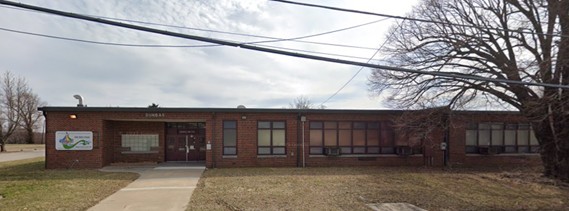Dunbar Elementary School (1955-2010)
Introduction
Text-to-speech Audio
Situated at 5419 E. 36th Street in the neighborhood of Dunbar, the former Dunbar Elementary School has long served as a staple of this historically Black neighborhood. Named for Black poet Paul Laurence Dunbar, the first iteration of the Dunbar school was established at 5515 E. 36th street in 1917. During this time, beginning in the 1890s, many Black families moved to previously-white industrial community, as it was one of the few areas of Kansas City where realtors would sell to non-whites. (AAHTKC) The current building was constructed from 1954-55, opening to students in February of 1956, according to the Kansas City Star. The single-story school building included a mixed-use auditorium/gymnasium that with a high ceiling and raised stage. Several notable Kansas Citians attended this school, including Senator Yvonne Wilson, Alvin Brooks, Will McCarther, and Reverend Kenneth Ray. Unfortunately, the population Dunbar began to decline as residents drained out towards the suburbs, leaving much of the housing vacant. In 2010, Dunbar Elementary School was closed, a victim of cost-saving measures on the part of the school district. However, community meetings held by the district in 2011 revealed a deep community connection to the school, saving the building from demolition. Since 2016, the building has been occupied by the Carousel Adult Day Care center, breathing new life into a long-standing fixture of the Dunbar neighborhood.
Images
The former Dunbar Elementary School is now home to an adult daycare

Backstory and Context
Text-to-speech Audio
The origin of Dunbar Elementary School is inextricably intertwined with the broader history of the Dunbar area. According to the African-American History Trail of Kansas City, the first development in the area was white families attracted by nearby manufacturing jobs. In the early 1900s, Dunbar was attractive to Black families, as there were not many other places that realtors would sell to them at the time. Despite the lack of modern fixtures such as electricity or indoor plumbing, the African-American population expanded as new families moved in. The population continued to grow after the end of the First World War, as manufacturing jobs became more accessible and the quality of housing rose.
In 1917, the first iteration of the Dunbar School opened in a church at 33rd and Oakley. Soon after, a near-tripling enrollment count forced the school to move to an eight-room building at 36th and Oakley, now the location of Dunbar Park. (K.C. Public Library) The school remained at this location for several decades, with older students commuting to Lincoln High School. The currently-existing building was constructed over 1954-1955. It has a single story, and contains nine classrooms, office space, and a mixed-use auditorium/gymnasium with a high ceiling and raised stage. Articles and images published in the Kansas City Call and the Kansas City Star covered the opening of the new building, which included a march by sign-carrying students and a ribbon-cutting on February 20, 1956, and an open house with a program, including an invocation by Rev. W. E. Jordan and remarks from school district officials, was held on February 26th. Principal Edward E. Fields was quoted by the Kansas City Star, saying "I have served boys and girls in the poorest of Kansas City's classrooms and today I am serving in Kansas City's newest and finest.
Unfortunately, the benefits of the new school building did not last. As Kansas City desegregated, new and affordable developments in the suburbs caused many residents to seek out greener pastures elsewhere. Though the area is still occupied, relatively few buildings remain from the early days. The Dunbar Elementary School building nearly suffered the same fate in 2010, when it was shut down by Kansas City Public Schools. However, an August 9, 2011 community meeting revealed a deep community connection to the building, as well as pushback against demolition. With community members determined to keep the building around, the school remained empty for several years. In 2016, the City established a lease for Carousel Adult Day Care to begin improvements to the building. Carousel moved in under the lease in June of 2017, and bought the building outright on April 23, 2021. From humble beginnings, the Dunbar School building has served the community, and will no doubt continue to do so far into the future.
Sources
Bill Radford, “Dunbar Elementary School,” Kansas Room Special Collections, accessed December 5, 2022, https://kansascollection.omeka.net/items/show/132.
Drouin, Jeremy. “KC Q Dives into Story of Leeds, Where Black Families Flourished in a 'Garden of Eden'.” Kansas City Public Library, October 9, 2019. https://kclibrary.org/blog/kc-q-dives-story-leeds-where-black-families-flourished-garden-eden.
“Dunbar Phase II Meeting Summary.” Kansas City, MO: Kansas City Public Schools, August 9, 2011.
“Leeds/Dunbar Neighborhood.” African American Heritage Trail of Kansas City. Accessed December 6, 2022. https://aahtkc.org/leedsdunbar.
Minutes of Kansas City Schools and Dunbar Community Meeting, Thursday, April 28, 2011. "Dunbar Site Tour," https://www.kcpublicschools.org/about/repurposing/school-site-info-details/~board/school-sites-repurposing/post/dunbar-school
“School Site Details: Dunbar School.” Kansas City Public Schools. Accessed December 7, 2022. https://www.kcpublicschools.org/about/repurposing/school-site-info-details/~board/school-sites-repurposing/post/dunbar-school.
Google Streetview
